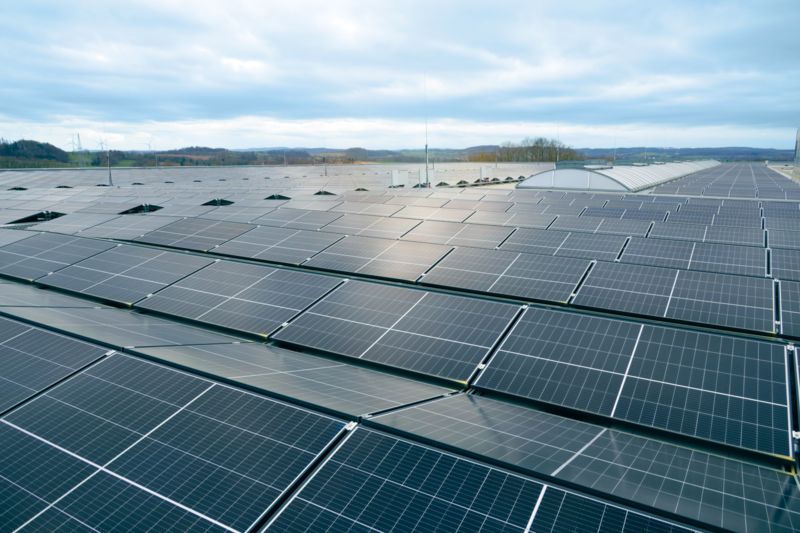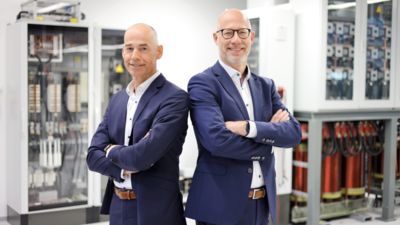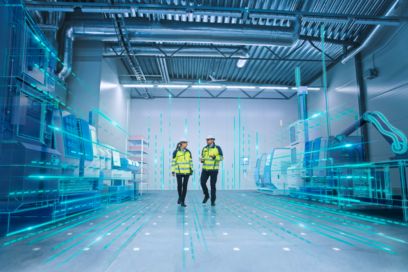The leap into reality Just doing it. A factory building has been built in Blomberg, Germany, in which production can be more energy-efficient and sustainable due to a sophisticated DC power grid. A look behind the scenes reveals how direct current works in practice.


2,760 solar panels on a roof area of 11,000 m²
The All Electric Society Factory
A sunny afternoon in Blomberg, Germany. Long rows of solar panels undulate on the 11,000 m² roof surface like a sea of glass. As soon as sunlight hits the semiconductor material, electricity begins to flow. Apart from the size of the system, this is a completely normal sight on many German roofs.
But this building is different: whereas elsewhere, inverters ensure that the direct current from the solar system is converted into alternating current, the electricity here flows directly into a local DC power grid. “A DC power grid optimizes the entire energy chain, from generation, through distribution, to storage, and consumption”, explains Tobias Lüke, DC power grid expert from Phoenix Contact.
The expert likes to start his tour of the building on the roof. Here, at the solar field, it becomes clear why direct current is on the increase everywhere. “Not only generators are increasingly working on a direct current basis, but also energy storage systems and loads. Most electrical devices and production units work with direct current”.

DC charging stations in front of the All Electric Society Factory
Compensating peak loads
Ten charging points are also available in front of the All Electric Society Factory. They are important players in the DC cosmos. Tobias Lüke therefore leads the way down to the parking lot, where the energy dispensers are lined up. “In the future, company cars will be able to use bidirectional DC charging stations (DC = direct current) to not only charge their traction batteries, but also feed energy directly back into the system without further conversion”, explains Lüke.
A look inside one of the charging stations shows that Phoenix Contact is well positioned for direct current. “Overvoltage and device protection, DC circuit breakers and DC charging connectors – the energy flows are controlled optimally by our power modules”.
But the vehicle batteries are far from everything: Tobias Lüke points to an inconspicuous white container. “A stable power supply based on renewable energies also needs sufficiently large and reliable storage systems to compensate for fluctuations”, explains the DC expert.
“And we can use these storage systems to compensate for peak loads instead of drawing from the public supply network”. Peak loads arise when, for example, large electrical motors in production machines are started up. In this event, they briefly consume more electricity than has been agreed with the supplier. And the supplier charges a high price for the extra in such cases. "By buffering peak loads with our batteries, we have been able to reduce electricity costs by up to 80%”.

Control cabinets for the DC power grid
Thinking, steering, and controlling
Tobias Lüke leads us into the technical catacombs of the building, down into the basement where the central nervous system of the DC power supply is located. Control cabinet after control cabinet line the walls. They do not only integrate photovoltaic systems, battery storage systems, and charging stations into the system. Electricity from the public grid is also drawn in here – and any surpluses fed back.
“Our power modules can also be operated bidirectionally – i.e., in both directions”, explains Lüke, opening a control cabinet in which the modules are aligned like drawers. “Thanks to the modular design, the control cabinets can be assembled flexibly and the power can be scaled very easily as required”.

DC control cabinet in the All Electric Society Factory
Less copper and more power savings
One turn, then the control cabinet is open. A whole mass of red and white in intimate togetherness – positive and negative in the DC power grid. What is also immediately clear to see is that the cables and other components are significantly smaller than those in conventional distribution systems – another advantage of this technology. “DC power grids require less copper for power transmission. This saves up to 55 percent of this expensive raw material”, says Lüke. The red and white strings from the photovoltaic system also end up here in the control center. They supply to the DC bus via DC/DC converters with a total power of 120 kW.
The DC electricity is distributed to the production area by the low-voltage main distribution. Here, the lighting works directly with the power from the DC grid. Two branches are routed to the connection to the production machines. “In the DC power grid, we can use the braking energy of robots and drives and return it directly to the system”, says Lüke, explaining the next important advantage of direct current. “This recuperation alone can achieve an increase in efficiency of up to 20 percent depending on the application.”
If, despite all the loads and storage systems, excess energy is still available in the DC power grid, the bidirectional AC/DC converters feed this power back into the public AC power grid in compliance with grid conditions.

CONTRACTON ELR HDC miniature circuit breakers
The concept becomes tangible
Wherever DC loads need to be safely switched in the All Electric Society Factory, the ELR HDC miniature circuit breaker is used. It combines the functions of protection, switching, monitoring, precharging, and network capability. Special DC energy meters record the energy flows. And the ArcZero DC connector is used to connect DC connections. This enables arc-free plugging and unplugging under load.
The PLCnext Engineer software platform handles load management and higher-level DC grid management and combines the individual areas into a comprehensive system. It combines the individual areas into a holistic system. The controller also integrates data such as electricity costs on the electricity exchanges, weather forecasts, and up-to-date data from the measuring station on the roof into the building’s energy management system.

Tobias Lüke, expert for DC grids
Not just talk
The All Electric Society Factory in Blomberg already has a reputation throughout the industry, far beyond Germany’s borders. Not just talk, but also action – direct current is already working here and now, as production designed for direct current demonstrates every day with its energy balance.
However, “This system was designed exclusively for test purposes and operational tests”, adds Tobias Lüke. Overall, the creators of this pilot project hope for further savings and increased efficiency. Among other things, the plan is to set up a small-scale wind turbine, an electrolyzer for hydrogen generation, and fuel cells, which in turn generate electricity from the stored hydrogen.
Phoenix Contact has been involved in researching and establishing DC technology for a long time and is a founding member of the Open Direct Current Alliance (ODCA). When the planning of the building began, there were hardly any components or standards for the use of DC technology on the market. Today, things are different, emphasizes Tobias Lüke. “With the available components, regulatory progress, increasing expertise, and collaboration with expert partners, it is also worth it for other companies to take the step to DC”.
Dark has fallen in Blomberg. We have come to the end of the tour and Tobias Lüke closes the gate to what is probably one of the most innovative factory buildings ever.

Summary
Direct current has long been with us in every corner of our everyday lives. But when you look at this energy holistically, there is a real treasure trove of savings potentials. The All Electric Society Factory was commissioned to unearth this treasure. And not just as a one-off, but as a blueprint for many other industrial and manufacturing buildings.
The introduction of direct current systems in production logistics and industry holds great potential for energy savings, especially for dynamic loads such as robots used in production: peak performance can be increased by up to 85% and energy efficiency by up to 20%.
If implemented consistently, the specter of expensive industrial electricity will quickly lose its terror. The building as an energy source and storage facility – here and now, with existing technology and in a tough production environment.
Connect with our experts

More posts

Direct current with a passion
Local direct current grids can save up to 20 percent energy, make the electricity generated directly storable and reduce the amount of resources required for their construction.

DC grids for sector coupling
E-mobility, solar systems, and battery storage systems are revolutionizing industry.




